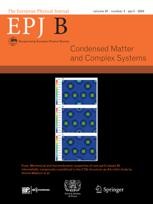Futuristic data storage based on controlling the interactions between nanodots magnetic ‘mood’ twirls
Better understanding of the changing magnetic state of nanometric squares in an array could be the basis for future ultrahigh density data storage
New York | Heidelberg, 19 June 2018
 The magnetisation of nanometric square material is not fixed. It moves around in a helical motion. This is caused by the electron whose degree of freedom, referred to as spin, which follows a precession motion centred on the middle of a square nano-magnet. To study the magnetisation of such material, physicists can rely on two-dimensional arrays of square nanomagnets. In a paper published in EPJ B, P. Kim from the Kirensky Institute of Physics, associated with the Russian Academy of Sciences, in Krasnoyarsk, Siberia, Russia, and colleagues have devised a new model taking into account the factors affecting the magnetic interaction between individual nanomagnets. Better controlling such nanomagnets arrays could have applications in ultrahigh density data storage,in an electronic application called spintronics exploiting electron spins and its magnetism, and in micro- and nanosurgery controlled by magnets.
The magnetisation of nanometric square material is not fixed. It moves around in a helical motion. This is caused by the electron whose degree of freedom, referred to as spin, which follows a precession motion centred on the middle of a square nano-magnet. To study the magnetisation of such material, physicists can rely on two-dimensional arrays of square nanomagnets. In a paper published in EPJ B, P. Kim from the Kirensky Institute of Physics, associated with the Russian Academy of Sciences, in Krasnoyarsk, Siberia, Russia, and colleagues have devised a new model taking into account the factors affecting the magnetic interaction between individual nanomagnets. Better controlling such nanomagnets arrays could have applications in ultrahigh density data storage,in an electronic application called spintronics exploiting electron spins and its magnetism, and in micro- and nanosurgery controlled by magnets.
The development of high-density data storage devices requires the highest possible density of elements in an array. However, the closer they are together, the greater the magnetic interactions between individual magnetic nanosquares. This translates as multiple magnetic resonance lines instead of the single resonance line that exists when these squares are further apart. This means that this multiple resonance stems from the several types of vibrational modes across the individual nanomagnets aligned with several vibrational modes of the overall array—instead of a single vibrational mode when the squares are further apart.
The originality of this work lies in the square geometry of the chosen nanomagnet. Unlike previous studies using different geometries, this work examines various combinations of polarity and chirality in arrays of a large number of elements.
Reference: P.D. Kim, V.A. Orlov, R.Yu. Rudenko, A.V. Kobyakov, A.V. Lukyanenko, V.S. Prokopenko, I.N. Orlova and T.V. Rudenko (2018), Collective Motion of Magnetization in Two-Dimensional Arrays of Square Elements, European Physical Journal B, DOI: 10.1140/epjb/e2018-90006-0
Further Information
For more information visit: www.epj.org
Services for Journalists
The full-text articles are available here.
Contact
Sabine Lehr | Springer | Physics Editorial Department
tel +49-6221-487-8336 | sabine.lehr@springer.com
